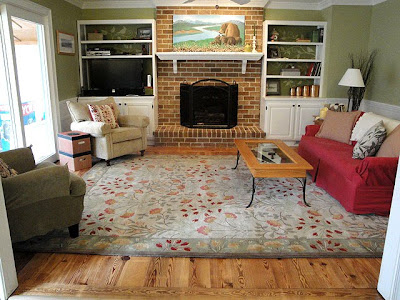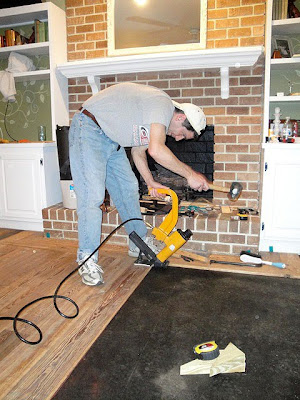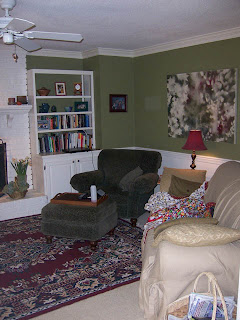Installing the Antique Heart Pine Flooring
Welcome back! If you are just joining us, we are on the fifth step of a five part series on our living room. A living room that started out as a dark cave of a room:
Previous steps can be viewed here:
1. Faux painting brick over a previously painted white brick fireplace
2. Lightening up a room in 5 steps
3. Painting decorative graphics on a wall
4. Preparing to Install Antique Heart Pine Floors (and living to tell about it!)
It has been four days since Christmas and we’ve been working like busy beavers on our living room. Only a few more days until Pretty Handsome Guy has to go back to work. Our boys are getting antsy and tired of being shooed from the living room.
Keeping the troops from getting restless:
I came up with a spur of the moment idea to keep them busy for a little longer! Painter’s tape and a coin made for an instant hop scotch game on the kitchen floor!
I quickly duck into the living room and start the installation process.
When choosing the direction to run the boards, I had to look under the house from our crawl space to see which direction the floor joists ran. We wanted our wood floor to run at a 90 degree angle (or perpendicular) to the joist direction. (This isn’t a rule, but it helps with the stability of your floor.) If you can’t get under your house (or want no part of that underbelly) then study the nail pattern on the plywood subfloor. The nails that are nailed into the floor joists will be in straight lines across the floor.)
To lay the flooring straight, I drew out guide lines in the living room.
Marking Start and End Lines:
- Mark the green line first (with chalk line) as your starting line.
- Measure the width of the room at the top and bottom.
- If these values differ, choose the lesser amount or close to it and mark that distance at the top and bottom of the room.
- Snap your chalk line between the two points.
Figuring First and Last Board Widths:
Before you nail in that first board (because I know you are itching to get started). You will need to do some math to figure out how many board widths you will use across your room. Take the total width of your room, divide it by your floor board width.
For example, our room is 187″ wide. My board widths are 5.5 inches wide. So, here is my equation: 187 ÷ 5.5 = 34″ Oh happy day, a whole number!!! I have room for 34 full width boards in our living room.
This very rarely occurs! Normally you end up with a number that has a fraction, let’s say .3 for example. You will be left with 1/3 of your board width at the end. This board won’t look good being so narrow, and it is harder to work with. If you had .5 or larger, you might be fine depending on your board widths. You will need to be the judge.
So, in the case of the .3 excess, you will need to split the difference between both your starter and end boards. Find out what .3 of your board widths is: 5.5 x .3 = 1.65. Then you will add that width to your standard board width: 1.65 + 5.5= 7.15″. Now divide the 7.15 in half: 7.15 ÷ 2 = 3.575. So, now you know that you need to rip your start and end board to be 3.5″ wide. I hope you followed that.
Time to learn two new glossary words:
- Rip – ripping a board is cutting with the grain along the length of a board. This is usually done with a table saw, but can be done with a circular saw and a straight edge.
- Cross cut – a type of cut that is perpendicular to the grain or along the width of your board. Cross cuts are usually made with a miter saw or circular saw, but can also be made with a hand saw. (I’ve been known to make this cut using my band saw before I had either a miter or table saw. Okay, I’ll have to give you a lesson on types of saws at a later date. I promise!)
Remember how I said we had a whole number, meaning our room will take full width boards. In other words, no ripping needed (guess we didn’t need that table saw after all. But, no way was I returning my Christmas present!)
Cutting and Dry Fitting the floor:
 I started by laying out all the boards across the room. Sounds easy right? WRONG!!! It wasn’t really difficult, just time consuming. I had to cut each board to size with the miter saw (this is where I really learned the value of the old adage “Measure twice, cut once.” Then, I moved to the next board. Several rows took two board lengths. I was careful to stagger my seams randomly. I also had to take more time to cut the profiles around door jams, fireplace, heating vents and bookcases. Also, be sure to cut a hole where your heating and A/C vent is (more detailed information on cutting profiles can be found in this post.) Cutting around a vent instructions can be found at OneProjectCloser.com here. Measure, cut, check fit (and repeat about 100 times).
I started by laying out all the boards across the room. Sounds easy right? WRONG!!! It wasn’t really difficult, just time consuming. I had to cut each board to size with the miter saw (this is where I really learned the value of the old adage “Measure twice, cut once.” Then, I moved to the next board. Several rows took two board lengths. I was careful to stagger my seams randomly. I also had to take more time to cut the profiles around door jams, fireplace, heating vents and bookcases. Also, be sure to cut a hole where your heating and A/C vent is (more detailed information on cutting profiles can be found in this post.) Cutting around a vent instructions can be found at OneProjectCloser.com here. Measure, cut, check fit (and repeat about 100 times).
I chose to create a mitered frame around our fireplace. This took a little more measuring and time, but the results were well worth the effort.
Phew, that only took a day and a half! I laid out ALL the floor boards without nailing. Moved a few to stagger seams or put prettier planks in a more prominent spot. When everthing fit, I lightly numbered each board with chalk and stacked them up near the end side of the room.
FINALLY! Install Your Floor:
Okay itchy fingers, now it is time to install that first board! Grab that huge pneumatic nailer, right?! What? No?! The nailer won’t fit close enough to the wall for your first (or maybe even second or third row.) Time to bust out the power drill and predrill your nail holes. I put holes approximately every 18″ about an inch in from the edge. Then hammered the nails in using a nail set to countersink the nails. Before you sand, you will need to add some wood putty to fill and hide the nail holes.
Ah ha, NOW you can grab that nailer! I have to admit I was a little nervous. I had never actually used a floor nailer (although my Dad has pictures to prove otherwise).
I was 5 people! And a tomboy, what can I say.
It is true, I had watched my parents lay wood floors. But, that was many many years ago. Luckily times have changed, and the tools are better. We rented a pneumatic nailer with a compressor so that the nailer would do most of the driving with forced air.
We lined up that second board. Used a scrap block of wood and a hammer to tap it firmly against the installed board. Then Pretty Handsome Guy gave me the nod letting me know I could proceed. I trembled a little as I lifted the rubber mallet. Then stopped, moved my feet wider and clear away from the nailer. Then raised the mallet. It was now or never! And {{WHAM!}} The mallet hit smack in the middle of the black button and a loud bang filled the room. Woot! What a rush! I just love power tools :-).
Back to work, one floor cleat in and about 400 more to go. Plenty of {{WHAM}} for me and Pretty Handsome Guy to share.
When we reached the end of the room, we had to ditch the nailer and predrill holes and hammer in the nails by hand again.
Ooo la la! Step back and admire that beautiful floor!
Because our floor planks were custom planed, they had varying heights. But, that wasn’t a big deal because we were planning on finishing our own floor.
Well, at first we were so scared of ruining our beautiful wood floors that we almost paid a professional to come finish them for us. But, Mark Kegler (the guy who planed the wood for us) reassured me that I could definitely do it myself.
He gave me a few tips on Refinishing Your Own Floors:
- Rent a drum sander (rented at Home Depot.)
- Watch some videos on YouTube for using a drum sander.
- Practice on a sheet of plywood to get the hang of it.
- When you reach the end of your row, gently raise or rock the sander up and of the floor.
- Whatever you do, DO NOT stop moving while the sanding drum is in contact with the floor.
- Rent an edge sander (rented at Home Depot.)
- Again watch a video on YouTube for how to use it.
- Again DO NOT STOP moving it while it is in contact with the floor.
- And hang on tight to that puppy, cause it will pull you into the next county if you let it.
- A side note on the edge sanders, this thing will really give you a good glute and hamstring workout (just in case you were looking for some added results. Okay, yes, I added this last bullet point.)
- Then rent a Square Buffer (or Random Orbital Sander). It will give you your fine sanding and buffing finishes. (Rented at Home Depot)
- Yup, you guessed it, watch a video on You Tube. Seriously, how did people learn anything before YouTube?
- Buy the most expensive floor finishing system they have (it will last much longer than a cheap polyurethane.) We used ProFinisher Water-Based Floor Polyurethane.
- It can be a water based system.
- The system should include a sanding sealer and a sealer (polyurethane or varnish).
- Follow the directions on the bottle.
This site: www.easy2diy.com has some a great video and information for the whole finishing process. They left off the square buffing step, but it’s your DIY project and you can buff if you want to!
After following all the directions for finishing the floor, we were left with….
I hope you noticed that I didn’t mention the stain color we used. That is because we didn’t use a stain. This is the actual color of antique heart pine wood! No stain, just glorious amber red heart pine.
Which we had to cover up with a rug. But, every once in a while I pull back the rug and admire this:
Here is the final reveal of our living room:
I should note that it took another few hours to cut, install, and paint the quarter round molding to hide the edges of the floor. And I had to wait a month for custom transition strips for the doorways and special heart pine quarter round for around the fireplace. But, I’m one proud and happy Pretty Handy Girl now!
Post Note:
Several people have emailed me asking where we got our rug. It is from Pottery Barn and is called Adeline.

























Your floors look fantastic! Was wondering if you used any filler or anything between the strips or were yours all very evenly cut. We have installed reclaimed pine floors and are having some issues with the spaces in between the boards. Would love to get your opinion.
Gail, the gaps happen after years of drying and shrinking. Our original floors in the house have gaps like you have described. Honestly, I have just left them be and accept the fact that it makes them look that much more aged. But, I do get frustrated by all the dirt and dust that falls into the cracks. A while ago I saw a tutorial where they had inserted rope into the gaps and stained it to fill the void. I didn’t like that solution, so I left well enough alone. But, you could try it if you like: http://www.thisoldhouse.com/toh/video/0,,1631562,00.html
Brittany I am considering undertaking a similar project. Where did you get the wood you used, if you do not mind me asking. I personally want a wide plank look… hard to find apparently.
Angela, yes, it is hard to find. We bought ours from a guy who tears down barns near the NC/VA border. I saw his listing on Craig’s List. He said that a lot of time the farm owners will let him sell some of the salvage pieces from the tear downs to help pay for his fee. I’m not sure where you live, but Mountain Lumber in Earlysville, VA is a good source.
I’m SO glad I found your blog! I just started a similar blog about our new home and we are planning to put hardwoods down. This was so helpful! Doing old reclaimed wood would be great to save some money, but I was very nervous about the finishing-it-ourselves part. I’ll definitely be coming back to this post when we are ready for wood floors. 🙂
Hi! My husband and I are working on an addition and are about to lay the reclaimed heart pine floors. Found your site to brush up – it’s been a long time since we’ve done this. Thanks for such a great article! We also have 3 boys and 1 dog – I understand the rug!
Julie
Wow!you are one talented girl. You have given me more inspiration just when I thought I didn’t know what to do with myself. The floors are purely beautiful. You have a lovely rug but the thought of it covering your hard and amazing work baffled me a little. Sorry to say it:( Anyway, you have a new follower. Love so many of the items on your website!
Best,
Tina
Tina, believe me, I’d love to leave it uncovered and stare at it daily. Sometimes I pull back the rug to peek at it. But, sadly with two boys and a dog, we need the rug for wrestling matches and to protect it from the dog nails ;-).
Brittany
Brittany,
Read your reply, believe me I understand. Been there and done that with 3 kids and 4 dogs. So, just keep lifting up that rug and admiring your work. You did it girl:)
Floors look beautiful. Where did you order the custom made transition strips from??? Were they heart pine?
Warren, thanks for your comment. We had a local cabinet maker in Raleigh, NC who made the transition strips out of some of the leftover heart pine pieces. He routed the pieces for me. I wonder if somewhere like Mountain Lumber may be able to help you: http://mountainlumber.com/
stunning. stunning. stunning. When are you available for hire? 🙂
You’re a first rate handy girl, Brittany. You really empowered us by just looking at the photos.
And the living room looks spacious and organized.
Two thumbs up while I continue nodding my head with a smile on my lips!!! 😀
I love how the floor turned out. Where did you get your painting that is above the fireplace? That is really cool.
First time visiting your blog – I had a wonderful visit! Thank you for sharing your wood floor tutorial. So helpful! I'll be back to visit soon.
Topless Tomboy 😉 I think I have a few pictures like that myself… thanks for reminding me… I need to find and burn those 😉 Love the floor – what a great job!
I "heart" your floor! Was it hard to find the flooring?